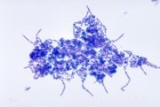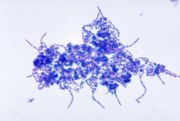
Mud fever
Encyclopedia

Horse
The horse is one of two extant subspecies of Equus ferus, or the wild horse. It is a single-hooved mammal belonging to the taxonomic family Equidae. The horse has evolved over the past 45 to 55 million years from a small multi-toed creature into the large, single-toed animal of today...
s causing irritation and dermatitis in the lower limbs of horses. Often caused by a mixture of bacteria, typically Dermatophilus congolensis
Dermatophilus congolensis
Dermatophilus congolensis is a gram positive bacterium and is the etiologic agent of a disease called Dermatophilosis in animals and humans, a dermatologic condition that manifests itself with the formation of crusty scabs that contain the microorganism. Some people erroneously call it mycotic...
, and Staphylococcus spp
Staphylococcus
Staphylococcus is a genus of Gram-positive bacteria. Under the microscope they appear round , and form in grape-like clusters....
, mud fever can also be caused by fungal organisms (dermatophyte
Dermatophyte
Dermatophytes are a common label for a group of three types of fungus that commonly causes skin disease in animals and humans. These anamorphic genera are: Microsporum, Epidermophyton and Trichophyton. There are about 40 species in these three genera...
s). Photosensitization
Photosensitivity in animals
Photosensitivity is an abnormal skin reaction to direct sunlight exposure. It is unrelated to a sunburn. These reactions are due to photosensitization, the accumulation of photosensitive compounds beneath the skin. In some cases, the photodynamic substances come from ingested plants or drugs, after...
, chorioptic mange mites, contact dermatitis and other conditions also contribute to some cases. This condition is often called scratches or dew poisoning, but is also known as pastern dermatitis, grease heel, or greasy heel.
Mud fever affects most horses and ponies during winter and early spring. Resulting in painful sores and scabs, which in severe cases can make a horse lame. Mud fever most commonly affects the pastern
Pastern
The pastern is a part of the leg of a horse between the fetlock and the top of the hoof. It incorporates the long pastern bone and the short pastern bone , which are held together by two sets of paired ligaments to form the pastern joint...
and heel
Heel
In human anatomy, the heel is the prominence at the posterior end of the foot. It is based on the projection of one bone, the calcaneus or heel bone, behind the articulation of the bones of the lower leg.- Human anatomy :...
area but can also affect the upper leg, the belly, and in some cases the neck area (also known as Rain Scald
Rainscald
Rainscald is a common skin disease in horses that is caused by Dermatophilus congolensis. This is the same organism that causes Mud fever in horses. This disease is very common in cows, sheep and goats and is also found occasionally in cats, dogs, and humans. D...
). Non-pigmented skin tends to be more severely affected.
Cause
Mud fever is caused by an infection of the skin by bacteria, including Dermatophilus congolensis, and often Staphylococcus spp. Dermatophytes (fungal organisms) can also contribute, as can chorioptic mangeMange
Mange is the common name for a class of persistent contagious skin diseases caused by parasitic mites. Since mites also infect plants, birds, and reptiles, the term "mange," suggesting poor condition of the hairy coat due to the infection, is sometimes reserved only for pathological...
mites. Photosensitivity may contribute in certain cases. Rarely, vasculitis
Vasculitis
Vasculitis refers to a heterogeneous group of disorders that are characterized by inflammatory destruction of blood vessels. Both arteries and veins are affected. Lymphangitis is sometimes considered a type of vasculitis...
can cause continued inflammation.
Under normal circumstances the skin acts as a protective barrier, preventing microorganisms from entering the horse's system and doing any damage. However, the integrity of the epidermis can become compromised through the abrasion of soil grit on cold, wet skin. The continual wetting of the skin causes a breakdown of the protective barrier of the epidermis, allowing the bacterium to enter and cause infection.
Shared boots, wraps, grooming supplies, and horse-handler's hands can all serve as fomite
Fomite
A fomite is any inanimate object or substance capable of carrying infectious organisms and hence transferring them from one individual to another. A fomite can be anything...
s, carrying the causative organism(s) from one individual to another. For this reason, mud fever should be considered a contagious disease, and general hygiene steps should be taken to limit cross-contamination.
Horses and ponies standing for hours in muddy, wet paddock
Paddock
A Paddock is an enclosure for horses. It may also refer to: People*Algernon Paddock , American politician*Charlie Paddock , American athlete and actor*Del Paddock , American baseball player...
s and at gates are a common sight during the winter months and early spring. It is in these conditions that mud fever thrives. Generally, those horses and ponies with white socks are more prone to the condition, although Mud Fever will affect horses of all breeds, ages and colours.
As with any bacterial infection, mud fever can become a very serious condition very quickly. The legs can become swollen and sore and open sores can become quickly infected. Often, such is the level of damage to the skin that these open sores can become very difficult to heal and can result in proud flesh
Proud Flesh
Proud Flesh is a German rock band from the early Krautrock era. The band was formed in 1969 in the former diplomat's city of Bonn-Bad-Godesberg and split up in 1972...
, permanent hair loss and in severe cases the need for skin grafts.
In draft horses
Draft horse
A draft horse , draught horse or dray horse , less often called a work horse or heavy horse, is a large horse bred for hard, heavy tasks such as ploughing and farm labour...
, particularly Clydesdales
Clydesdale (breed)
The Clydesdale is a breed of draught horse derived from the farm horses of Clydesdale, Scotland, and named after that region. Although originally one of the smaller breeds of draught horses, it is now a tall breed. Often bay in colour, they show significant white markings due to the presence of...
, Shires, and Belgians
Belgian (horse)
The Belgian Draft horse or Belgian, also known as Belgian Heavy Horse, Brabançon, or Brabant, is a draft horse breed from the Brabant region of modern Belgium, where it is called the or Flemish: . It is one of the strongest of the heavy breeds...
, a similar-appearing, but more serious condition occurs called chronic progressive lymphedema
Lymphedema
Lymphedema , also known as lymphatic obstruction, is a condition of localized fluid retention and tissue swelling caused by a compromised lymphatic system....
. This condition appears to be genetically-linked, starting early in life and progressing, causing thickening, fibrosis, and predisposing to secondary infections. This disease can progress enough to require euthanasia
Animal euthanasia
Animal euthanasia is the act of putting to death painlessly or allowing to die, as by withholding extreme medical measures, an animal suffering from an incurable, especially a painful, disease or condition. Euthanasia methods are designed to cause minimal pain and distress...
.
Paddock Management
Preventative action should be taken as soon as the paddocks start to become wet and muddy. Rotation of paddocks keeps horses from having to stand in wet, muddy ground. Electric fencing may also prevent horses from standing for long periods in the deep mud that collects in high traffic areas.Grooming
Washing the infected area with an antiseptic solution is part of the treatment for mud fever. However, washing a horse's legs repeatedly can remove the natural oils in the skin and may allow the condition to become established. The legs should be dried thoroughly after washing with antibacterial shampoo using paper towels,Care Products
There are many products available to help protect the skin from the constant wet by forming a barrier between the mud and the leg. However, barrier creams have the disadvantage that the horse's legs are still covered in mud when they come in from the field. Alternatively, some form of covering for the leg may be used such as Anti mud fever boots.Treatment
Keeping the horse out of the wet and mud is the first step in treatment of mud fever. Initial treatment also consists of clipping of the hair away from the infected area and use of an anti-bacterial lotion on the scabs to soften them and gently remove them. (The scabs should never be picked off - when they are ready they will rub off after being softened. Picking them off can possibly cause more infection and spreading). When the scabs come off, the skin is kept clean and dry. A Veterinary SurgeonVeterinary surgeon
Veterinary surgeon is a term used to describe:*The full title of a vet, who treats disease, disorder and injury in animals, in the United Kingdom and several Commonwealth countries**See also Veterinary medicine in the United Kingdom...
is consulted for further treatment.
See also
- RainscaldRainscaldRainscald is a common skin disease in horses that is caused by Dermatophilus congolensis. This is the same organism that causes Mud fever in horses. This disease is very common in cows, sheep and goats and is also found occasionally in cats, dogs, and humans. D...
- VetSci - Mud Fever Infographic

